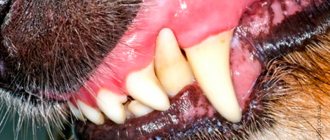If you are thinking about breeding your male or female dog, consult your veterinarian to learn about the important steps to take to ensure safe and healthy breeding practices.
Additionally, female dogs should not be vaccinated while pregnant, so please check with your veterinarian that your dog is vaccinated and on heartworm/flea preventative before breeding.
While your dog may not need as many doctor visits as humans do during pregnancy, you need to know how to care for your pregnant dog before, during, and after she gives birth. This guide will tell you how to prepare a place for puppies, what to feed pregnant dogs, what to expect during delivery, how to provide postpartum care, and how to care for your new puppies.
Here are some important tips to help keep your dog and her puppies healthy and happy.
- Signs of Pregnancy in Dogs
- Is there a pregnancy test for dogs?
- How long does a dog's pregnancy last?
- What to feed pregnant dogs
- How to prepare for your dog's birth
- How long does it take for dogs to give birth? The first stage of labor in dogs: the onset of contractions
- Second stage of canine labor: stronger contractions and labor
- Third stage of canine labor: afterbirth
- Vaginal discharge
- Keep your dog on a high calorie diet
- Approach puppies carefully
Is there a pregnancy test for dogs?
Methods to confirm pregnancy include an ultrasound of the dog's pregnancy, which should be done on the 25th day of pregnancy, as well as blood tests, which can be done on the 35th day, and an abdominal x-ray, which can be done on the 45th day. Discuss these methods with your veterinarian for more information.
False pregnancy in dogs (spooning) or pseudopregnancy is thought to be caused by a hormonal imbalance that allows non-pregnant dogs to exhibit symptoms such as lactation and behavioral changes.
These changes usually occur one to two months after the end of estrus and can last up to a month.
If these signs do not go away, treatment for the false pregnancy is usually not required. However, if your dog is not going to breed, spaying him may prevent future episodes.
How long does it last
Pupping in females normally lasts from 57 to 62 days. In some cases, it can last up to 72 days, and the babies are also born viable. If labor has not begun on days 72–73, this is an alarming sign and a reason to take the animal to the veterinarian.
The duration of pregnancy largely depends on the following factors:
- Once again the bitch gets pregnant. Primiparas bear their offspring longer.
- Age of the female. Elderly people often walk around.
- Animal size, small dogs give birth earlier.
The numerical indicators of normal pregnancy duration mentioned above are not absolute and the same for all dogs.
In small breeds
Gestation of puppies for representatives of small breeds lasts 60 days - less than for large breeds
A peculiarity of pregnancy in small dogs is that the uterus, significantly increasing in volume, puts pressure on the epigastric region, creating discomfort for the dog and affecting the processes of food digestion. Because of this, the expectant mother should be fed in small portions and be quite high in calories.
In medium breeds
Pregnancy in medium-sized dogs lasts from 60 to 63 days.
If gestation is prolonged or signs of premature onset of labor appear, the lives of the bitch and puppies will be at risk
The cause of premature birth may be injury, hidden pathology, critical weight loss, or the age of the dog. When a bitch is about to give birth at the wrong time, you should inform the veterinarian who is seeing the pet about this.
In large breeds
Pregnancy in large dogs lasts from 63 to 65 days. As mentioned above, the duration of pregnancy depends not only on the size of the animal, but also on other indicators. To predict your pet dog's due date, you should consult your veterinarian. Based on the medical history, he will be able to determine it.
What to feed pregnant dogs
Pregnant dogs should be switched to a higher calorie diet at 4 weeks of pregnancy (about one month into pregnancy). This may be a commercial diet designed for pregnancy and lactation, or a diet designed for puppies.
There are several high-quality diets recommended by veterinarians for pregnant dogs.
Bitches should remain on this high calorie diet until weaning. It is important to note that large breed puppy food is generally not recommended for pregnant or lactating dogs due to lower levels of calcium, phosphorus and energy.
Pregnant and lactating bitches have a much higher metabolic demand associated with growing, giving birth and feeding puppies, so these diets can help ensure adequate nutrition.
Your dog will have less space in his stomach, so he will need to eat less and more often.
How to prepare for your dog's birth
Towards the end of your dog's pregnancy, you should create a quiet nesting area for the birth (or puppies). This area should be warm and comfortable, and your dog should be able to come in and out as he pleases, all while being respectful of the puppies.
It is also important to isolate the mother from other dogs three weeks before giving birth and three weeks after giving birth to prevent infection with the herpes virus. This virus rarely causes illness in adult dogs, but can be fatal in puppies.
A pregnant dog's temperature will drop below 38°C within 24 hours of giving birth, so you should start taking her temperature a few days before her due date. For the most accurate measurement, temperature should be taken rectally.
Diagnosis, course and birth in dogs. Management of pregnancy.
Waiting for a new addition to your beloved pet is a very exciting event not only for the dog itself, but also for its owner.
And if everything goes well, without complications - the new mother and the babies are healthy and feel great, then this is real joy and happiness! But in order for everything to happen just like that, the owner will have to make a lot of effort and be extremely attentive. There is no point in hoping that “Mother Nature” will do everything herself. Firstly, in nature only the strongest individuals survive. Secondly, do not forget that many selective breeds require special care even in everyday care.
How long does it take for dogs to give birth?
Canine labor is divided into three stages. Contractions in the first stage can last 6-12 hours. Puppies are usually born 45-60 minutes apart, but the mother dog may take up to four hours between puppies. Here's what happens at each stage.
The first stage of labor in dogs: the onset of contractions
The first stage is defined as the relaxation of the cervix and the beginning of intermittent contractions. However, you are unlikely to notice contractions at this stage of the labor process.
During this stage, your dog will become restless, going in and out of the nesting box, panting, digging, and sometimes even vomiting. This stage can last 6-12 hours.
Second stage of canine labor: stronger contractions and labor
The second stage of labor begins with stronger and more frequent uterine contractions, which ultimately lead to the birth of the puppy. Puppies are usually born every 45-60 minutes, with 10-30 minutes of vigorous straining. Expect some puppies to be born tail first, as this is normal for dogs.
The mother takes a break during whelping, and she may not exert herself at all for four hours between puppies.
If your dog strains for more than 60 minutes or requires more than a four-hour break, take him to the vet as soon as possible.
What to do after the birth of a puppy?
Puppies are born with a protective fetal membrane, which the mother dog usually removes shortly after birth.
If she does not remove this sac, you must manually remove it to stimulate the puppy's breathing. Tear open the bag, wipe the liquid out of the puppy's nostrils, then open the mouth upside down and wipe away any remaining liquid. Stimulate your puppy's breathing by gently stroking him with a towel.
If the umbilical cord was not cut during birth or by the mother, you will need to cut it, but be careful not to pull on the umbilical cord, as this can damage the puppy's organs. Tear it about an inch away from the puppy's body by carefully tearing it off with two fingers and your thumb.
Third stage of canine labor: afterbirth
The final stage of labor is the passage of the placenta. You will see a greenish-black mass of membranes (sometimes called "afterbirth") that is released after each puppy is born.
How to resuscitate a puppy if he is not breathing?
Sometimes it happens that the bladder ruptures in the birth canal and amniotic fluid enters the baby’s respiratory tract. If the puppy is breathing weakly (or not breathing at all), the following manipulations will help:
1. Using a syringe, free the puppy’s mouth and nose from mucus; sometimes you need to suck out the liquid with your mouth; 2. if there is a lot of liquid in the mouth, place a thin gauze swab in the oral cavity for a few seconds - it will absorb the mucus; 3. open the puppy’s mouth and gently pull out the tongue; as a last resort, if the puppy is breathing but weak, you can drop ONE drop of cognac onto the tip of the tongue; 4. place a waffle towel on your palm, place the puppy on your palm, cover with a towel and thoroughly, confidently but carefully, rub it in the direction from the tail to the neck (you need to rub the puppy with a towel and preferably a waffle one, since the texture of this material is perfect for this rough massage); 5. take the puppy with both hands, wrap it in a waffle towel, fix the neck and head, and intensively but carefully shake the baby, wave your arms (as if chopping wood, but the range of movements should be small); 6. Take the puppy with both hands so that it lies across your palms, and gently stretch and squeeze it (like an accordion). Movements must be very careful!; 7. When performing artificial respiration, inhale air into the baby’s lungs through the nose very carefully; the lung capacity of a newly born puppy is very small.
What to look for after your dog gives birth
Here are some things to expect and pay attention to after your puppies are born.
Vaginal discharge
Vaginal discharge may continue in small amounts for up to eight weeks after the puppies are born. The discharge is usually reddish-black in color because it consists mainly of old blood.
If the discharge is excessively bloody, has an odor, or looks like pus, your dog should be seen by a veterinarian as soon as possible.
Heat
It is normal for mothers to have a fever (greater than 102.5°F) within 24 to 48 days after giving birth, but this should not be accompanied by signs of illness.
Metritis (inflammation of the uterus)
Metritis, or inflammation of the uterus, can occur due to retained placenta or trauma during childbirth. If you notice signs of fever, lack of appetite, smelly vaginal discharge, lack of interest in the puppies or milk production, contact your veterinarian immediately.
Eclampsia (drop in blood calcium levels)
Eclampsia can occur within the first three weeks after birth and is caused by the mother's inability to meet calcium requirements during lactation. This is commonly seen in toy breeds, and calcium supplementation during pregnancy predisposes the dog to this condition.
Dogs suffering from this condition will experience restlessness, muscle spasms, a stiff gait, and even seizures. Please consult your veterinarian as soon as possible if you notice any of these behaviors.
Mastitis (infected breast tissue)
Mastitis, or inflammation of the breast tissue, occurs when the breasts become hard, red, and tender due to infection. The mother will likely be sore while nursing, but it is important for the puppies to continue suckling to reduce swelling and promote the elimination of infected material.
If you are concerned that your dog may develop mastitis, contact your veterinarian as your dog will likely need treatment.
Agalactia (does not produce milk)
Agalactia occurs when dog milk is either not produced or is not released. If puppies are nursing well but are not getting milk, it is important to seek help from a veterinarian.
The first milk, or "colostrum", provides the puppies with essential nutrients and antibodies from their mother to help them develop natural immunity to infections.
If they do not receive these important nutrients within the first few days of life, they may require additional veterinary care.
Postpartum care
Here are the steps you need to know for postpartum care, nutrition and care.
Keep your dog on a high calorie diet
Your dog should be on a higher calorie diet (pregnancy or puppy) while she is nursing (nursing puppies). Make sure she always has food and fresh water on hand.
Create a private space for your dog and puppies
Keep the mother dog and her puppies in a clean, quiet, low-traffic area. If there is too much noise around her, she may become nervous and begin to neglect her puppies.
Monitoring puppy feeding
Newborn puppies need to feed from their mother's milk every 1-2 hours, so your dog will likely be with them constantly for the first week or two.
If you think your dog is not producing milk or not allowing puppies to nurse, contact your veterinarian immediately.
Medicines and vaccines should be avoided while your dog is nursing.
Call your veterinarian if your dog seems sick
If your dog is sick, call your veterinarian immediately and let them know she is nursing a baby so they can prescribe safe medications if necessary.
If your dog stops eating, vomits, or becomes very lethargic (weak and tired), or if you notice redness and swelling in any of his mammary glands, contact your veterinarian.
Pet behavior before birth
Most bitches become timid; an unexpected meeting with other animals or the raising of the owner's voice can have a detrimental effect on her condition. The dog becomes calm, plays less often and is active. Even temperamental breeds show sedateness and complaisance. Usually, bitches are more affectionate during pregnancy and require the support and attention of the owner. Appetite changes - in the early stages it decreases, and then greatly increases. If the dog does not eat at all, it is recommended to consult a specialist.
As whelping approaches, the bitch begins to look for a quiet and secluded place in the house and refuses to eat. When giving birth is imminent, the bitch shows anxiety - she scratches the floor, whines and walks in circles in one place.
Photo: flickr.com
Consider sterilization
To address the serious problem of overpopulation, talk to your veterinarian about spaying or neutering your dog. This is the only contraceptive for dogs.
The cost of an unwanted pregnancy can be very high. Proper veterinary care for a litter of up to 14 puppies adds up quickly, and an emergency C-section can cost thousands of dollars.
In general, small breed dogs should be spayed at a younger age, while spaying of large and giant breed dogs may be delayed until they are a little older.
Small breed dogs tend to go into heat earlier than large and giant breed dogs, and recent evidence suggests that allowing some large breed dogs to become skeletal mature before spaying or neutering may reduce the risk of joint problems later in life.
Since there are no universal guidelines for when to spay or neuter your dog, ask your veterinarian for a specific recommendation. Most dogs are spayed or neutered between 4 and 6 months of age.
It is also important to consider the risk of pyometra (infection in the uterus), which is a life-threatening condition that can occur in intact (not spayed) dogs. The best way to prevent this serious and costly disease is to have your dog spayed.
Spaying before his first heat cycle (which can occur as early as 6 months of age) can also reduce your dog's risk of mammary cancer.
Duration of pregnancy by week
Pregnancy and its timing depend on several factors..
- Firstly, the duration is determined by the size and age of the female . In small breeds, puppies can be born 55-60 days after fertilization. Large dogs give birth no earlier than the 60th day , the ideal time is 63-65 days . Pregnancy in young individuals may take a little longer.
- Possible diseases also influence the timing of the course . There is often a need for surgery if the puppies are too large for the female. Premature birth can be caused by exhaustion, infectious disease or traumatic injury.
Regular medical examinations, tests and proper nutrition will help you avoid problems with birth.
1-2 weeks
It is important to keep records of pregnancy from the first day, noting changes in behavior and problems with the dog’s well-being . In the first week, the egg is fertilized and moves through the folic tube. On days 10-14, the embryos attach to the uterus and begin their development.
During this period, the female may refuse to play, eat, and be picky about certain foods. Toxicosis is observed.
3-4 weeks
At week 3, the embryos develop rapidly. An organ system and skeleton are formed. Starting from this period, an ultrasound can be performed, which can already show the embryos. On day 21, the placenta appears.
The fourth week is the formation of eyes, ears, limbs and skulls in puppies; embryos reach 1-1.5 cm . They can be felt (just below the abdomen).
Toxicosis intensifies due to the fact that the uterus presses on the female’s stomach. There is swelling and redness of the nipples.
5-7 weeks
A period of rapid growth. By day 30, puppies have already reached 20% of their proper weight. By day 35, the embryos are approximately 6-7 cm in length. The female's belly increases and the dog gains weight. At this time, it is customary to feed the girl often, but in small portions.
The bitch becomes restless, protects her belly, hides it . Instinctively looking for a place to give birth, it is important to prepare a cozy enclosure or a soft bed. No toxicosis is observed, but the dog refuses to eat, is cautious, and reduces activity. Milk may appear on days 50-55 The size of the puppies is 14-20 cm.
Final week 8
After 53-55 days, labor may begin suddenly. A sharp drop in temperature indicates that the puppies will appear within 24 hours. Outwardly, it may be noticeable how grown-up babies move in the stomach. The belly sinks and becomes heavier.
Puppies care and nutrition
Follow these guidelines for caring for newborn puppies.
Approach puppies carefully
Although you can pet and hold puppies constantly, it is important not to interfere too much in the first week or two of their life as they are very susceptible to illness and this can be stressful for mom and babies.
Be careful when approaching puppies, as some mothers may become aggressive towards people or other pets if they feel threatened.
As puppies get older and more rambunctious, your dog will want more and more time to sleep, sleep, exercise, or interact with family members. Give your dog a chance to get away from the puppies, but make sure he comes back often to check on them.
Provide warm bedding
Puppies cannot regulate their own body temperature until they are 3 to 4 weeks old. For the first four weeks of their lives, you should provide mother and puppies with a warm, clean crate or bedding.
Use a heating pad under the puppy crate or a lamp above it to keep the puppies warm. Make sure there are unheated areas as puppies will need to move away from the heat source if they get too hot. The temperature in the warm zone should be around 36°C.
Start socializing your puppies
At this point, if the mother dog allows it, you can get the puppies accustomed to your presence. Interacting with them at an early age can help them fit into the household well.
Keep an eye out for "poor workers" or "puppies" (puppies that are much smaller and don't grow as quickly as their littermates) as they may have health problems that affect their ability to grow. If you notice that one of your puppies is smaller or has less energy than the others, consult your veterinarian.
Puppies should not be taken away from their mother and sent to a new home too quickly, as they learn very important social rules and behaviors from their mother and siblings.
Puppies should not be separated from their mother if they are less than 8 weeks old. Wait until they are 10 weeks old so they can get the most benefit from social interaction with their mother and littermates.
Start weaning at 3-4 weeks of age
Once the puppies are 3-4 weeks old, you can begin the weaning process by giving them access to puppy food. You can mix dry food with water or canned puppy food to make it easier for them to eat.
They should still have constant access to their mother as she will continue to breastfeed them. Over the next few weeks they will rely more and more on puppy food rather than being fed. Most dogs wean their puppies between 5 and 6 weeks of age.
Contact your veterinarian immediately after the puppies are born.
Contact your veterinarian for his or her recommendations on when puppies should be examined first.
They may want to see them right away to evaluate for cleft palate, umbilical hernia and other health problems, or they may advise you to wait until they are a little older.
Many veterinarians recommend deworming at regular intervals, starting at 2-4 weeks of age and vaccinating at 6 weeks of age.
False pregnancy
False pregnancy is the condition and behavior of an unmated bitch or one that is mated but not whelped, when she shows signs of a pregnant dog. This occurs against the background of hormonal disorders caused by temporary hormonal disruption or disruption of the internal secretion organs.
Signs and causes
The reason for false pregnancy is that the corpus luteum in the female’s ovary does not dissolve with the end of estrus, but remains in the body for some time, so physiologically this is perceived as the onset of pregnancy.
The dog's behavior changes greatly during this period. Signs of false puerility include the fact that it:
- begins to arrange a den for future puppies;
- treats toys as if they were her own babies - licks them, puts them under her belly, and collects them in her den;
- finds it more difficult to cope with physical activity:
- indifferent to walks and games;
- at times becomes nervous and excited;
- jealously suppresses attempts by people to approach the den and take the “puppies.”
In addition to behavioral changes, physiological changes are also observed:
- the beds swell, their pigmentation intensifies;
- colostrum is released;
- mucus drains from the swollen loop (external genital organ);
- the animal's appetite worsens.
It is impossible to distinguish imaginary pregnancy from true pregnancy in the early stages without resorting to medical diagnostics.
False pregnancy in dogs lasts from 2 to 3 weeks and often goes away on its own. If this does not happen, special measures will be required to return the dog to normal.
How to alleviate the condition of an animal
False pregnancy is dangerous due to complications, especially if it happens more than once, but is repeated periodically. Changes in the mammary glands associated with the onset of milk secretion can eventually cause mastitis, and hormonal imbalances cause inflammatory processes in the uterus, up to pyometra.
Pyometra in dogs is an inflammation of the uterus, in which purulent discharge accumulates in its cavity. As a rule, pyometra in a dog develops shortly after estrus, when the level of the hormone progesterone increases in the body.
To stop imaginary puppies, you should:
- Take measures to reduce lactation by temporarily eliminating all dairy products from the dog’s diet.
- Reduce the size of food portions.
- Control the amount of water consumed. It should not significantly exceed the norm.
- Provide your dog with normal physical activity. She should walk, run, play more. This is good for health, and in addition, it will allow her to take her mind off the worries of caring for imaginary “puppies.”
- Do not express milk from the dog’s glands, hoping that its production will stop. This can only stimulate lactation.
- Disassemble the den equipped by the bitch, remove “false children” from sight, make sure that the dog cannot be in places where there are puppies and pregnant bitches for some time.
As a rule, this is enough for the pet to feel better and return to normal life. If home measures do not produce results, you will have to show the female to the veterinarian.
It is possible that hormonal therapy will be needed to normalize the condition. A list of medications and a treatment regimen will be prescribed by a veterinarian. He will also control the dynamics of the animal’s condition.
If signs of mastitis appear, treatment of the nipples or application of compresses with camphor oil to them is indicated. To prevent the animal from getting rid of the lotions ahead of time, the stomach is bandaged with an elastic bandage.
An attentive and caring owner whose bitch suffers from spooning from time to time should think about sterilizing her. This will save the animal from unnecessary suffering and preserve its health and life.
Pregnancy for a pet is a difficult, albeit happy time. In order for it to pass without complications, and for the offspring to be born on time, the dog must be observed by a veterinarian. A competent and responsible owner will certainly take care of this.











